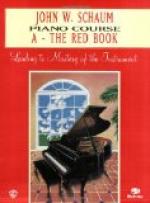The brilliant young pianist, Ethel Leginska, who is located for a time in America, was seen in her Carnegie Hall studio, on her return from a concert tour. The young English girl is a petite brunette; her face is very expressive, her manner at once vivacious and serious. The firm muscles of her fine, shapely hands indicate that she must spend many hours daily at the keyboard.
“Yes, I have played a great deal in public—all my life, in fact—ever since I was six. I began my musical studies at Hull, where we lived; my first teacher was a pupil of McFarren. Later I was taken to London, where some rich people did a great deal for me. Afterward I went to Leschetizky, and was with him several years, until I was sixteen; I also studied in Berlin. Then I began my career, and concertized all over Europe; now I am in America for a time. I like it here; I am fond of your country already.
“The piano is such a wonderful instrument to me; I feel we are only beginning to fathom its possibilities; not in a technical sense, but as a big avenue for expression. For me the piano is capable of reflecting every mood, every feeling; all pathos, joy, sorrow—the good and the evil too—all there is in life, all that one has lived.” (This recalls a recently published remark of J. S. Van Cleve: “The piano can sing, march, dance, sparkle, thunder, weep, sneer, question, assert, complain, whisper, hint; in one word it is the most versatile and plastic of instruments.”)
“As for the technic of the piano, I think of it only as the material—only as a means to an end. In fact I endeavor to get away from the thought of the technical material, in order that I may get at the meaning of the music I wish to interpret. I am convinced there is a great future for the piano and its music. Even now we are taking piano music very seriously, and are trying to interpret it in a far deeper and broader sense than the pianists of, say, fifty years ago ever thought of doing. I fancy if Clara Schumann, for instance, could return and play to us, or even Liszt himself, we should not find their playing suited to this age at all. Some of us yet remember the hand position Mme. Schumann had, the lack of freedom in fingers and arms. It was not the fashion of her time to play with the relaxed freedom, with the breadth and depth of style which we demand of artists to-day. In those days relaxation had not received the attention it deserved, therefore we should probably find the playing of the greatest artists of a former generation stiff and angular, in spite of all we have heard of their wonderful performances.
“Relaxation is a hobby with me; I believe in absolute freedom in every part of the arm anatomy, from the shoulder down to the finger-tips. Stiffness seems to me the most reprehensible thing in piano playing, as well as the most common fault with all kinds of players. When people come to play for me, that is the thing I see first in them, the stiffness. While living in Berlin, I saw much of Mme. Teresa Carreno, and she feels the same as I do about relaxation, not only at the keyboard, but when sitting, moving about or walking. She has thought along this line so constantly, that sometimes, if carrying something in hand, she will inadvertently let it drop, without realizing it—from sheer force of the habit of relaxation.




